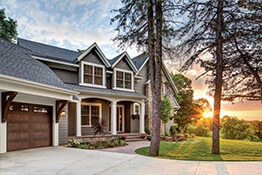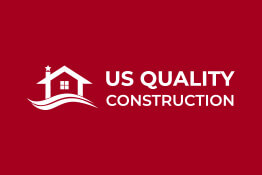Hardboard siding (sometimes referred to as pressboard siding) is a synthetically built home siding product composed of wood fibers, glues, and resins. Heat and pressure bind the hardboard siding products together throughout the production process.
Builders have a wide range of options for materials to choose from. The ultimate choice is generally influenced by the project's structural and weather-resistance requirements, as well as the builder's budget.
Exterior siding options range from engineered hardwood to fiber cement to imitation stone and brick veneer. Vinyl, stucco, aluminum and steel, and T1-11 and composite board are the least costly siding options in the center of the pricing range.
Hardboard siding, which we commonly call "traditional," is a low-cost and simple-to-install option. Hardboard siding products are more durable and adaptable than siding made of wood. Vinyl is more expensive than wood, although it might cost between 25 percent and 50 percent more.
Hardboard Siding's Positive Qualities
Original products like Masonite, have been replaced by hardboard siding. Although Masonite no longer makes siding materials, the moniker is still used by builders and suppliers to describe current hardboard siding products. Despite the bad press it still receives, hardboard has some advantages. Unlike conventional wood, which is prone to cracks and other surface concerns, composite and surfaced plank board variations can be painted virtually.
For homes with older-style Masonite or clapboard siding that needs minor repairs, the easiest option is hardboard lap siding. Hardboard is a solid and long-lasting material. If you use a power washer to clean your siding, you risk damaging the surface and allowing water to seep into the structure. If you keep an eye out for signs of cracks or holes in the siding, you'll be able to maintain the integrity of the siding. Replace any missing or loose sealants and nails as soon as you see them.
Compared to wood or metal siding, hardboard siding products are a more cost-effective option. They are very cost-effective because they can withstand the elements for a long time as long as the protective finish is maintained. Hardboard siding products may last for many years if regularly inspected and maintained.
The Issues With Hardboard Siding
Damage and Deterioration
A low-cost, low-maintenance substitute for real wood siding was marketed as Masonite. Natural appearance texture is achieved by using a mold made of wood to produce it, and it is commonly composed of wood and resin or wood and glue. Unfortunately, it had many of the same issues as natural wood, in addition to a few new ones. Even though today's hardboard is a little more forgiving, the early stuff tends typically to rot and degrade after a while. If you touch it, it may crumble in your hands or significant portions missing from each board. This is because as the glue or resin wears out, the wood might begin to deteriorate and come apart. Also, insects and moisture may get in if you don't keep up with priming and painting, which can lead to various issues. Look for boards that seem to be decaying, missing parts, or coming apart during a yearly check of your home's exterior. If you see any of these warning signals, it's time to get rid of everything and start again.
Buckling & Blistering
The most obvious concern is the deterioration and rot of the boards, but there are a few additional difficulties that might arise before this occurs. Many older hardboard siding products show signs of buckling and scorching. If you locate any of these, your siding is likely to start deteriorating and rotting soon after they've been discovered. When these problems begin to arise, you have a bit more time to get your siding fixed, but you still need to make an appointment with a contractor as soon as possible. Not to mention that your house will be unattractive while you wait. Moisture and expansion cause the boards to buckle, resulting in warping. When the panels aren't sitting flat against your house, you'll notice it. So not only will your siding begin to deteriorate quickly, but it will also seem a little shabby in the interim. Internal layers begin to break and detach, resulting in blistering. Blisters occur inside the boards as a result of this. Your boards may be starting to deteriorate if they aren't equally challenging when you feel them.
The Excessive Maintenance
Hardboard, rather than wood, was presumably sold to you as a low-maintenance alternative. This, unfortunately, is not the case. Like wood, hardboard siding must be primed and painted. Moisture and insects can infiltrate, causing the boards to rot and degrade if they aren't adequately protected. Caulking is another thing you should keep an eye on. Caulk should be used to seal the gaps and edges between the hardboard pieces. Over time, caulk is prone to cracking, especially if your house moves around a lot. If that caulk is crumbling or peeling, the time to remove and replace deteriorated caulking must be taken. Moisture and insects can get into your boards if you don't do this. It is still necessary to coat and caulk even newer hardboard forms, although they may survive longer than earlier variants. Vinyl or wood painted with a vinyl-based "paint" are the best low-maintenance options, so don't settle for what you've got. You should consider replacing your home's hardboard siding if it's exhibiting indications of decay or degradation or if you're having difficulty maintaining it.
Other Siding Options Besides Hardboard
LP SmartSide engineered wood siding and James Hardie, fiber cement siding, are two excellent options for siding.
Siding made of chipped Aspen wood, a unique resin formula, zinc borate for treatment, and a phenolic acid overlay is called LP® SmartSide®. It is an LP® product. Consequently, a product that is both water-resistant and strong is created. Because there is no special cutting equipment necessary, it is less expensive to install than Hardie Board, which comes in shorter lengths and weighs more.
However, it should be noted that Hardie Board fiber cement siding is not the same thing as "hardboard," which is a thick and thin pressed particle board usually produced from wood. In the form of HardiePlank® and HardiePanel®, the fiber cement siding from Hardie Board is offered in horizontal and vertical variations. Portland cement, powdered sand, cellulose fiber, and other chemicals are combined to generate these fiber cement siding materials in a patented recipe. Concrete, cement fiber siding, and fiber cement cladding have been dubbed generic terms because of their widespread use.
Tags: Hardboard Siding,













